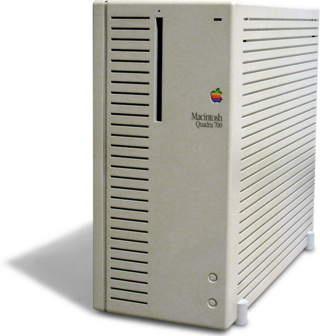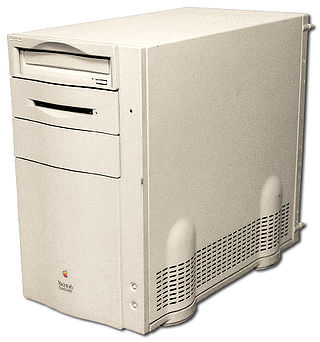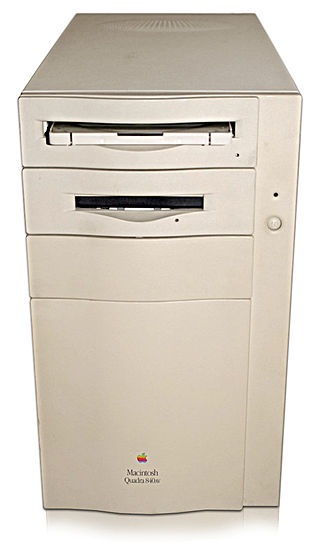
The Power Macintosh, later Power Mac, is a family of personal computers designed, manufactured, and sold by Apple Computer, Inc as the core of the Macintosh brand from March 1994 until August 2006.

The Macintosh Classic is a personal computer designed, manufactured and sold by Apple Computer from October 1990 to September 1992. It was the first Macintosh to sell for less than US$1,000.

The Macintosh II is a personal computer designed, manufactured, and sold by Apple Computer from March 1987 to January 1990. Based on the Motorola 68020 32-bit CPU, it is the first Macintosh supporting color graphics. When introduced, a basic system with monitor and 20 MB hard drive cost US$5,498. With a 13-inch color monitor and 8-bit display card, the price was about US$7,145. This placed it in competition with workstations from Silicon Graphics, Sun Microsystems, and Hewlett-Packard.

The Macintosh IIsi is a personal computer designed, manufactured and sold by Apple Computer, Inc. from October 1990 to March 1993. Introduced as a lower-cost alternative to the other Macintosh II family of desktop models, it was popular for home use, as it offered more expandability and performance than the Macintosh LC, which was introduced at the same time. Like the LC, it has built-in sound support, as well as support for color displays, with a maximum screen resolution of 640 × 480 in 8-bit color.
Apple Inc. has sold a variety of LCD and CRT computer displays since introducing their first display in 1980. Apple paused production of their own standalone displays in 2016 and partnered with LG to design displays for Macs. In June 2019, the Pro Display XDR was introduced, however it was expensive and targeted for professionals. In March 2022, the Studio Display was launched as a consumer-targeted counterpart. These are currently the only Apple-branded displays available.

The PowerBook Duo is a line of subnotebooks manufactured and sold by Apple Computer from 1992 until 1997 as a more compact companion to the PowerBook line. Improving upon the PowerBook 100's portability, the Duo came in seven different models. They were the Duo 210, 230, 250, 270c, 280, 280c, and 2300c, with the 210 and 230 being the earliest, and the 2300c being the final version before the entire line was dropped in early 1997.

The Apple Cinema Display is a line of flat-panel computer monitors developed and sold by Apple Inc. between 1999 and 2011. It was initially sold alongside the older line of Studio Displays, but eventually replaced them. Apple offered 20, 22, 23, 24, 27, and 30-inch sizes, with the last model being a 27-inch size with LED backlighting.

The iMac G4 is an all-in-one personal computer designed, manufactured, and sold by Apple Computer from January 2002 to August 2004. The computer is comprised of a hemispheric base that holds the computer components, including the PowerPC G4 processor, attached to a flatscreen liquid-crystal display (LCD) via a stainless steel arm that allows the monitor to be easily tilted and swiveled.

Radius Inc. was an American computer hardware firm founded in May 1986 by Burrell Smith, Mike Boich, Matt Carter, Alain Rossmann and joined by other members of the original Macintosh team like Andy Hertzfeld. The company specialized in Macintosh peripherals and accessory equipment. It completed its IPO in June 1990.

The Macintosh Quadra 700 is a personal computer designed, manufactured and sold by Apple Computer from October 1991 to March 1993. It was introduced alongside the Quadra 900 as the first computers in the Quadra series, using Motorola 68040 processor in order to compete with IBM-compatible PCs powered by the Intel i486DX. The Quadra 700 is also the first computer from Apple to be housed in a mini-tower form factor, which in 1991 was becoming a popular alternative to standard desktop-on-monitor cases that were common through the 1980s.

Apple Inc. has designed and developed many external keyboard models for use with families of Apple computers, such as the Apple II, Mac, and iPad. The Magic Keyboard and Magic Keyboard with Numeric Keypad designed to be used via either Bluetooth and USB connectivity, and have integrated rechargeable batteries; The Smart Keyboard and Magic Keyboard accessories for iPads are designed to be directly attached to and powered by a host iPad. All current Apple keyboards utilize low-profile key designs, and common modifier keys.

The Macintosh Quadra 605 is a personal computer designed, manufactured, and sold by Apple Computer from October 1993 to July 1996. The model names reflect a decision made at Apple in 1993 to follow an emerging industry trend of naming product families for their target customers – Quadra for business, LC for education, and Performa for home. Accordingly, the Performa 475 and 476 was sold in department stores and electronics stores such as Circuit City, whereas the Quadra was purchased through an authorized Apple reseller.

The Macintosh Quadra 800 is a personal computer that is a part of Apple Computer's Quadra series of Macintosh computers.

The Power Macintosh 6200 is a series of personal computers designed, manufactured, and sold by Apple Computer from May 1995 to July 1997. The 6200 is the PowerPC-based replacement for the Quadra 630, with the same form factor and price range. In early 1997, the rather different Power Macintosh 6300/160 / Performa 6360 based on the Power Macintosh 6400 was introduced. The whole line was discontinued when the desktop model of the Power Macintosh G3 was released.

The Macintosh Quadra 840AV is a personal computer designed, manufactured, and sold by Apple Computer from July 1993 to July 1994. It was introduced alongside the Centris 660AV, where "AV" signifies audiovisual capabilities, such as video input and output, telecommunications, speech recognition, and enhanced audio. The 840AV has the same mini-tower form factor as the Quadra 800, with a faster Motorola 68040 processor.

The Macintosh Quadra 660AV, originally sold as the Macintosh Centris 660AV, is a personal computer designed, manufactured and sold by Apple Computer from July 1993 to September 1994. It was introduced alongside the Quadra 840AV; the "AV" after both model numbers signifies video input and output capabilities and enhanced audio.

The Macintosh Quadra 650, originally sold as the Macintosh Centris 650, is a personal computer designed, manufactured and sold by Apple Computer from February 1993 to September 1994. The Centris 650 was introduced alongside the smaller Centris 610 as the replacement for the Macintosh IIci and Quadra 700, and it was intended as the start of the new midrange Centris line of computers. Later in 1993, Apple decided to follow an emerging industry trend of naming product families for their target customers – Quadra for business, LC for education, and Performa for home – and folded the Centris 650 into the Quadra family.

The HDI-45 was one of Apple Computer's proprietary cable-to-onboard video connectors. A 45-pin connector, the HDI stands for High-Density Interconnect.

The Apple Studio Display is a series of non-widescreen LCD and CRT displays manufactured and sold by Apple Computer, Inc. and introduced in 1998. After the 1999 introduction of the widescreen Apple Cinema Display, the Apple Studio Display line ran concurrently until it was discontinued in 2004. With the exception of the last model, the 5:4 17" Apple Studio Display, all Apple Studio Displays had an aspect ratio of 4:3.
Apple Inc. has produced and sold numerous music and multimedia speakers, available for standalone purchase and bundled with Macintosh products.



















